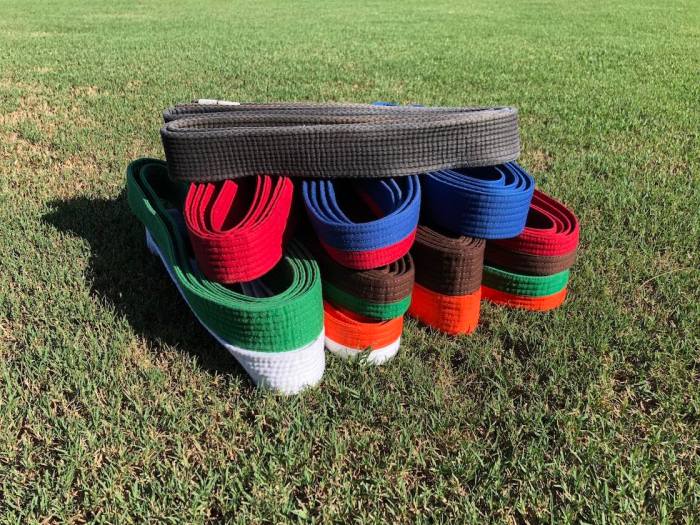Tang Soo Do belt colors are a vibrant tapestry of tradition, symbolism, and martial prowess. From the humble white belt to the coveted black belt, each color represents a distinct milestone in a practitioner’s journey. Embark on a captivating exploration of the progression system, techniques, and values associated with these iconic belts.
As we delve into the world of Tang Soo Do, we’ll uncover the significance behind each belt color, from the foundational white to the esteemed black. We’ll explore the rigorous testing process and the martial arts techniques that accompany each level, gaining a deeper understanding of the discipline and its rich history.
Belt Colors in Tang Soo Do

The belt colors in Tang Soo Do, a Korean martial art, represent the progress and achievements of its practitioners. Each color signifies a level of skill and understanding.
The belt colors in Tang Soo Do, from lowest to highest rank, are as follows:
White Belt
The white belt is the starting point for all Tang Soo Do practitioners. It symbolizes purity, innocence, and the beginning of the learning journey.
Yellow Belt
The yellow belt represents the sun, the source of life and energy. It signifies the student’s growing knowledge and the beginning of their technical development.
Green Belt
The green belt symbolizes the growth and development of the student. It represents the student’s progress in mastering the basics of Tang Soo Do and their increasing confidence.
Blue Belt
The blue belt represents the sky, which is vast and boundless. It signifies the student’s broadening horizons and their increasing understanding of the art.
Tang soo do practitioners advance through a hierarchy of belt colors, each representing their level of skill and experience. These colors can vary slightly depending on the school or style, but typically range from white to black. If you’re looking for a refreshing break from the rigors of training, why not try your hand at making some tropical rum buckets? Here’s a guide to help you craft the perfect summery cocktail.
Once you’ve savored the sweet and fruity flavors, you can return to your tang soo do practice with renewed vigor and focus.
Red Belt
The red belt symbolizes danger and warning. It signifies the student’s increasing power and the need for caution and control.
Black Belt
The black belt is the highest rank in Tang Soo Do. It represents maturity, wisdom, and mastery of the art. The black belt is not an end point, but rather a symbol of ongoing learning and dedication.
Progression System
The progression system in Tang Soo Do is a structured and merit-based system that recognizes the student’s progress and skill development. Advancement through the belt colors is based on a combination of technical proficiency, physical fitness, and knowledge of the art.
Testing Process
Students must undergo regular testing to demonstrate their mastery of the techniques and principles associated with each belt color. The testing process typically involves a combination of:
- Physical fitness tests (e.g., push-ups, sit-ups, jumping jacks)
- Technical demonstrations (e.g., forms, self-defense techniques, sparring)
- Written or oral examination on the history, philosophy, and principles of Tang Soo Do
The difficulty of the testing requirements increases as students progress through the belt colors, reflecting the increasing level of skill and knowledge required at each level.
Belt Colors and Requirements
The Tang Soo Do belt system typically consists of the following colors, each with its own set of requirements:
| Belt Color | Requirements |
|---|---|
| White | Basic techniques, fundamental principles, introduction to history and philosophy |
| Yellow | Refinement of basic techniques, introduction to advanced techniques, increased physical fitness |
| Orange | Proficiency in basic and advanced techniques, sparring fundamentals, increased knowledge of history and philosophy |
| Green | Refinement of advanced techniques, self-defense applications, increased sparring skills, deeper understanding of history and philosophy |
| Blue | Mastery of advanced techniques, advanced sparring skills, increased physical fitness, comprehensive knowledge of history and philosophy |
| Red | Exceptional technical proficiency, advanced sparring abilities, significant knowledge and experience in Tang Soo Do |
| Black | Highest level of achievement, mastery of all aspects of Tang Soo Do, continuous dedication and refinement of skills |
It’s important to note that the specific requirements and testing process may vary slightly depending on the Tang Soo Do school or organization.
Martial Arts Techniques

Tang Soo Do is a martial art that emphasizes powerful kicks, fast strikes, and dynamic forms. The techniques associated with each belt color reflect the student’s progress and mastery of these fundamental elements.
White Belt
White belts learn the basic stances, kicks, punches, and forms that form the foundation of Tang Soo Do. These include:
- Stances: Front stance, back stance, horse stance, cat stance
- Kicks: Front kick, roundhouse kick, side kick, back kick
- Punches: Front punch, back punch, side punch, uppercut
- Forms: Chon-Ji, Dan-Gun
Yellow Belt
Yellow belts continue to refine their basic techniques and learn more advanced variations. They also begin to develop their sparring skills.
- Stances: Walking stance, triangle stance, crescent stance
- Kicks: Crescent kick, hook kick, axe kick, jump kick
- Punches: Reverse punch, hammer fist, elbow strike
- Forms: Do-San, Ge-Baek
Green Belt
Green belts focus on developing power and speed in their techniques. They also learn more complex forms and begin to incorporate weapons into their training.
- Stances: Cat stance with twist, horse stance with shift
- Kicks: Turning kick, spinning hook kick, double jump kick
- Punches: Knifehand strike, palm strike, back fist
- Forms: Pyong-Ahn, Sam-Il
- Weapons: Bo staff, nunchucks
Blue Belt
Blue belts continue to develop their power and speed, and they begin to focus on developing their own unique style. They also learn more advanced sparring techniques.
- Stances: Cross stance, low stance, fighting stance
- Kicks: Flying side kick, tornado kick, whip kick
- Punches: Double punch, triple punch, finger jab
- Forms: Pyong-Ahn, Sa-Jang
- Weapons: Sword, sai
Red Belt
Red belts are advanced students who have mastered the basics of Tang Soo Do. They focus on refining their techniques and developing their own personal style. They also learn more complex forms and weapons.
- Stances: Dragon stance, tiger stance, crane stance
- Kicks: Triple jump kick, spinning heel kick, tornado kick
- Punches: Dragon punch, tiger punch, crane punch
- Forms: Pyong-Ahn, Oh-Dang
- Weapons: Double sticks, tonfa
Black Belt
Black belts are the highest rank in Tang Soo Do. They have mastered all of the techniques of the art and are able to teach and guide other students. Black belts continue to train and develop their skills throughout their lives.
- Stances: All stances
- Kicks: All kicks
- Punches: All punches
- Forms: All forms
- Weapons: All weapons
Etiquette and Values
Etiquette and values play a pivotal role in Tang Soo Do, guiding the conduct of practitioners at each belt level. These principles foster respect, discipline, and personal growth, shaping the behavior of students both within and outside the dojang.
Respect
- Students show respect to their instructors, fellow practitioners, and opponents.
- They bow to acknowledge each other and demonstrate humility.
- They refrain from using offensive language or gestures.
Discipline
- Practitioners adhere to the rules and regulations of the dojang.
- They maintain a clean and orderly training environment.
- They arrive on time for class and practice diligently.
Personal Growth
- Tang Soo Do encourages students to strive for self-improvement.
- They set goals, work hard, and never give up.
- They develop a strong sense of perseverance and determination.
Comparison with Other Martial Arts

Tang Soo Do shares some similarities with other martial arts like Taekwondo and Karate in terms of belt colors and progression systems. However, there are also some notable differences.
Belt Colors
In Tang Soo Do, the belt colors generally follow a progression from white to black, with various colored belts in between. The specific colors and their order may vary slightly depending on the style or organization, but common colors include white, yellow, orange, green, blue, red, brown, and black.
Taekwondo and Karate also use a similar belt color progression, with some variations in the specific colors and their order. For example, in Taekwondo, the belt colors typically progress from white to black, with yellow, green, blue, and red belts in between.
In Karate, the belt colors may vary depending on the style, but common colors include white, yellow, orange, green, blue, brown, and black.
Progression Systems
The progression systems in Tang Soo Do, Taekwondo, and Karate are similar in that they involve a series of tests or exams that students must pass to advance to the next belt level. These tests typically assess students’ knowledge and skills in various areas, such as forms, techniques, and sparring.
However, there are some differences in the specific requirements and progression systems of each martial art. For example, in Tang Soo Do, students typically need to demonstrate proficiency in a set of forms, techniques, and sparring skills to advance to the next belt level.
In Taekwondo, students may also need to demonstrate knowledge of self-defense techniques and sparring strategies.
Historical Origins: Tang Soo Do Belt Colors
The origins of Tang Soo Do belt colors can be traced back to the ancient Korean martial art of Taekkyon.
During the Joseon dynasty (1392-1910), Taekkyon practitioners wore white belts to signify their beginner status. As they progressed in their training, they would earn colored belts to denote their increasing skill and experience.
Influences and Traditions
The current Tang Soo Do belt color system was influenced by several factors, including:
- Korean culture:The use of colors to represent different levels of achievement is a common practice in Korean society.
- Japanese martial arts:When Tang Soo Do was introduced to Japan in the early 20th century, it adopted the colored belt system used in Japanese karate.
- Western martial arts:The Tang Soo Do belt color system also incorporates elements from Western martial arts, such as the use of black belts to denote mastery.
Design and Symbolism
The Tang Soo Do belt system incorporates a variety of colors, patterns, and materials to represent the progression and skill level of its practitioners. Each belt holds significant meaning and symbolism.
The belts are typically made of thick cotton or canvas, providing durability and flexibility. The width and length of the belts vary depending on the rank, with higher-ranking belts being wider and longer.
Color Symbolism, Tang soo do belt colors
The colors of the Tang Soo Do belts represent different stages of development and symbolize the elements of nature:
- White:Purity, innocence, and the beginning of the journey.
- Yellow:Earth, stability, and the foundation of knowledge.
- Green:Growth, progress, and the sprouting of new skills.
- Blue:Sky, vastness, and the limitless potential of the practitioner.
- Red:Fire, passion, and the power of the martial artist.
- Black:Maturity, mastery, and the culmination of the journey.
Pattern and Material
In addition to the colors, the belts also feature distinct patterns and materials:
- Stripes:Many belts incorporate stripes of different colors to indicate the sub-ranks within a particular level.
- Embroidery:Some belts are adorned with embroidery, such as the Korean flag or the Tang Soo Do logo, representing the martial art’s heritage.
- Material:Higher-ranking belts are often made of thicker, more durable materials, such as leather or satin, to signify the increased skill and experience of the practitioner.
Essential FAQs
What is the significance of the white belt in Tang Soo Do?
The white belt symbolizes purity, innocence, and the beginning of a practitioner’s journey.
How many belt colors are there in Tang Soo Do?
There are typically 10-12 belt colors in Tang Soo Do, depending on the specific lineage and school.
What is the highest belt color in Tang Soo Do?
The highest belt color in Tang Soo Do is black, which represents mastery and lifelong dedication to the art.